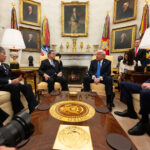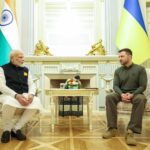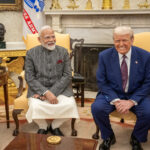The day arrived, but not many were nursing any illusion that President Donald Trump was going to throw in any extensions. Official India seemed ready for August 27, knowing full well that at least in the short term several sectors were going to be hurt, from Jaipur in Rajasthan to Tirupur in Tamil Nadu, and for one reason or another. Labor-intensive units were already feeling the pinch from competition in the neighborhoods of South and South-East Asia.
The 25 percent tariffs imposed by the Trump administration were seen as steep; on top of that, to add sanctions of another 25 percent for purchasing Russian oil to make it 50 percent was something unbelievable in many quarters, including in the United States.
And in some instances, this 50 percent would have to be added to the already existing tariffs. If first calculations are anything to go by, the tariffs will impact more than 60 percent of Indian exports to the United States, factoring in that certain sectors like energy products, pharma, and electronic goods are not covered by the new duties. It is said that in Fiscal 2026, India’s goods exports may decline to about US$ 50 billion from the current US$ 87 billion. And in terms of the impact on the Indian economy, the decline in GDP is put at between 0.8 to 1 percent. India’s growth has been pegged at between 6 and 6.5 percent.
What stunned India on the Russian oil front was the rationale and logic behind Washington’s moves, starting with the fact that China, which imports more oil from Russia—to the tune of about 60 percent of its needs—was spared the so-called secondary sanctions. The argument that countries were bankrolling Russian war efforts in Ukraine only seemed to apply to India. Worse, Indian oil purchases were vigorously encouraged by the United States under the Biden administration with a view to maintaining stability of prices in the global market; and for the first six months, the Trump administration hardly seemed to pay any attention to the Russian “front.”
And quite some time ago, India’s External Affairs Minister S. Jaishankar had pointed out that Europe buys more Russian oil in an afternoon than India does in a month! But the kicker was in a charge that India was re-selling its cheap oil to make a buck.
In fact, leading American media outlets pointed out that India had started buying more oil from America in the past year as well as holding out the promise of buying more defense hardware. Indian energy imports from the United States, The New York Times says in a report, reached US$ 6.6 billion in the first six months of 2025, a 70 percent increase over the same period last year.
Still, if all this cut little ice with the man sitting in the Oval Office, the reasons would have to be elsewhere, it is surmised. After all, Russian President Vladimir Putin has himself said that his country’s exports have shown a 20 percent increase since the time President Trump came to office for his second non-consecutive term this January; and word is that Washington and Moscow are themselves in talks on oil and energy sectors.
There is a near consensus and conviction in many quarters, including overseas, that the reasons for high tariffs and additional sanctions on India have little to nothing to do with India being a “tariff King” or to make Russia poor enough to wean it forcibly from the conflict in Ukraine. Neither would it have to do with countries in the BRICS—Brazil, Russia, India, China, and South Africa—trying to undermine the policies of the United States, especially trying to find alternatives to the dollar. Now word comes through a German publication that in recent days President Trump had tried calling Prime Minister Narendra Modi four times, but the call went unanswered.
The news report has not merited any official response from New Delhi or Washington, but those in the guessing game have stepped to the plate offering one of two reasons why President Trump’s call did not connect: the Indian Prime Minister is not in the habit of making deals over the phone; or was apprehensive of what President Trump could make of the call and the conversation and put out his version publicly.
The real answer to President Trump’s change of tack on India has perhaps to do with anger and irritation with New Delhi stressing that the White House had little to do with stopping the brief India-Pakistan war in the aftermath of Pakistan-backed terrorist attacks on tourists in Pahalgam and in the fiery response of India by way of Operation Sindoor. Every time President Trump repeated his contention—and one count at the time of writing puts it at forty—New Delhi denied it. And as a way to perhaps irritate New Delhi, the Trump White House rolled out the red carpet to the top brass hat of Pakistan, Field Marshal Asif Munir, the Chief of the Army Staff, and promised a whole lot of goodies including oil exploration.
But perhaps President Trump was not drawn attention to a reported statement made by Pakistan’s Deputy Prime Minister and Foreign Minister, Ishaq Dar. “We did not ask the United States or any other country to arrange talks. The ceasefire request came from Pakistan,” he told media persons. More than India, this statement would seem to put a dent in the long list of brokered peace achievements and could to some extent impact President Trump’s quest for a Nobel Prize.
The hefty tariffs and sanctions are a wake-up call to India. Economically, it is an opportunity to not only look for short-term fixes but, more importantly, for longer-term structural reforms that are needed for export and import sectors. And strategically, India would need to do some serious rethinking.
For some 25 years, the India-United States relationship has been carefully constructed and nurtured by different Presidents and Prime Ministers. The question is if this jolt by way of tariffs and secondary sanctions is only a passing phase or something that will force New Delhi into rethinking its role globally and in the Indo-Pacific, including in the QUAD.
Disclaimer: The opinions and views expressed in this article/column are those of the author(s) and do not necessarily reflect the views or positions of South Asian Herald.






